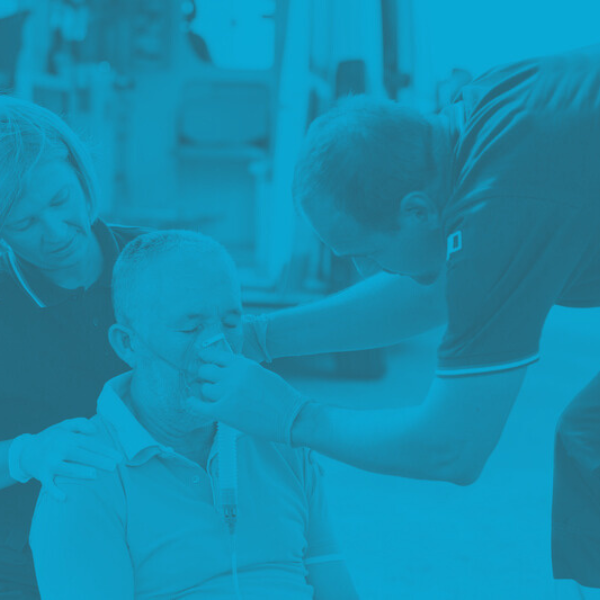Ways to Improve Heart Health Naturally and Safely
Ways to Improve Heart Health Naturally and Safely

by Greta Kviklyte
Life Saver, AMC
Co-authored by Kim Murray, RN, M.S.
posted on Sep 24, 2022, at 2:53 am
As someone working with patients who may have heart problems, it is important to understand heart health. Make sure you have tips and advice to share with patients who are interested in taking better care of their heart and cardiovascular system. This will help you save lives and improve the quality of life for your patients. Start by understanding what a healthy heart rate is, and then learn about ways to better manage heart health.
What is a Healthy Heart Rate?
Before you can make recommendations for heart-healthy foods and exercises, consider the patient’s heart rate.
We offer Online CPR and BLS Certification
A healthy heart rate for an adult, according to specialists, is 60 to 100 beats per minute. This heart rate is the normal resting rate for an adult. If you are an athlete who participates in exercise more frequently, you could have a lower resting heart rate.
The typical resting heart rate for athletic individuals is 40 beats per minute. If you have a heart rate that is over 100 beats per minute, this is a sign of cardiac distress. Anything over 140 indicates the patient is at risk of having a heart attack.
How do I calculate my heart rate without equipment?
To help someone who is having heart problems, start with calculating their heart rate. You can do this without medical equipment. Find the person’s pulse, which can be detected by holding their wrist or feeling next to the person’s windpipe. Once you feel a heartbeat called the pulse, start counting the heartbeats.
Keep a count of how many beats there are in 15 seconds. Then multiply this number by 4 to get the average number of heartbeats per minute. This is a person’s heart rate. Of course, the heart rate will vary over five minutes. Therefore, it is a good idea to consider an average heart rate taken over a 10-minute span.
This average heart rate can provide a more accurate picture of overall heart health. Sometimes a patient will be anxious when getting their blood pressure taken, which can lead to an unexpected spike. Having an average rate of over 10 to 15 minutes will help reduce inaccurate readings.
What is a heart rate that is too low called?
 When someone has a heart rate that is too low, this is lower than 60 beats per minute. Keep in mind, that if you are dealing with an athlete, they may have a lower heart rate. However, the general rule is any time a heart rate is less than 60, the person is suffering from bradycardia. The person may be exhibiting signs of a low heart rate. These symptoms include fainting spells, shortness of breath, and feeling dizzy when standing.
When someone has a heart rate that is too low, this is lower than 60 beats per minute. Keep in mind, that if you are dealing with an athlete, they may have a lower heart rate. However, the general rule is any time a heart rate is less than 60, the person is suffering from bradycardia. The person may be exhibiting signs of a low heart rate. These symptoms include fainting spells, shortness of breath, and feeling dizzy when standing.
What do you call a heart rate that is too high?
A heart rate over 100 beats per minute is a sign of a high blood pressure rate. Having a high pulse rate is indicative of heart health problems. These include cardiovascular disease, hypertension, and high cholesterol. Here is when having heart-healthy tips on hand to share with a patient is most advantageous.
What are the signs of poor heart health?
Poor heart health starts with having a too low or too high heart rate. When your heart rate is not healthy, this means your heart is having a hard time beating properly. If you have a slow heart rate, the heart cannot pump fast or hard enough to keep up the pace of your blood vessels and cardiovascular system. If your heart is beating too fast, this is also a problem with the pace of your heart’s beats.
Generally, this is caused by constricted blood vessels and the use of stimulants, including caffeine and nicotine, which unnaturally increase heart rate. When the heart beats too fast and too hard, this causes unnatural wear-and-tear on the heart muscle and blood vessels going in and out of the organ.
Symptoms of poor heart health include sweating or not being able to sweat, leading to clammy skin. You may also have pale skin due to a lack of circulating blood. Additionally, if your heart is beating too fast, you may have red skin from too much blood flow. This is most commonly noted in a patient’s face or on their chest. As the heart is related to the blood and lungs, a lack of oxygen in the body may also be a sign of poor heart health.
How can I make my heart healthy?
 The heart is the most important organ in a person’s body. Without a heart, a patient is unable to live due to a lack of blood and oxygen pumping and being circulated throughout the body. Brain-dead patients are living on life support, for example, and patients get by every day without an arm or leg.
The heart is the most important organ in a person’s body. Without a heart, a patient is unable to live due to a lack of blood and oxygen pumping and being circulated throughout the body. Brain-dead patients are living on life support, for example, and patients get by every day without an arm or leg.
However, the heart is super vital to the health and wellbeing of any patient. Therefore, it is imperative that a patient makes heart-healthy choices if they want to improve their heart health and live a healthier life overall.
Heart Healthy Foods to Eat
What are the best foods to eat for heart health?
A patient’s diet is the best place to start with heart health. There are many foods you can eat that will improve heart health–and many foods that will lead to a decline in heart health. The best foods you can eat for heart health are:
- Fatty fish containing Omega-3 fish oil
- Fibrous green vegetables, namely lettuces and greens with vitamin K
- Citrus fruits containing vitamin C
- Beans for protein without saturated fats or cholesterol
If you are eating to improve heart health, focus on vitamins and minerals to aid in heart productivity.
What are the benefits of eating Omega-3 fish oil and fish products for heart health?
Omega-3 fish oils are sourced from fatty fish, such as salmon. This fish oil helps lubricate the blood vessels to assist in transporting blood cells and oxygen. According to MedlinePlus, “[Omega-3 fats] reduce triglycerides, a type of fat in your blood. They reduce the risk of developing an irregular heartbeat (arrhythmias). They slow the buildup of plaque, a substance comprising fat, cholesterol, and calcium, which hardens and blocks your arteries.”
How do fiber and fibrous foods help someone who has heart problems?
Fibrous foods that are green offer a double whammy. Fiber is necessary for the digestive system in that it helps push out debris and toxins caught in the digestive tract. Otherwise, these toxins can build up, especially in the case of bad cholesterol, and fill up the blood vessels. This can cause a heart attack due to blockages. Fiber reduces blockages by being undigested and used as a broom to sweep through the digestive tract.
What are vitamin K foods and how do these help the heart?
The use of vitamin K is important for thinning the blood. In fact, if your patient is suffering from blood clots and taking Warfarin to thin their blood, they may not be able to eat vitamin K-rich foods like spinach because it thins the blood too much. As such, eating vitamin K, which is found most abundantly in green foods, will naturally thin a patient’s blood. Vitamin K-rich foods reduce the risk of a blood clot related to a heart attack for patients who eat them.
How do vitamin C foods help patients with heart health and immunity?
Vitamin C is selected for patients who want to boost their heart health. This vitamin is more commonly associated with citrus fruits, such as lemons and oranges. When eating vitamin C, this substance improves cardiovascular health by increasing immunity against diseases and viruses.
If you have a patient with poor heart health, they are more susceptible to illnesses, such as upper respiratory tract infections or bronchitis. In this case, patients who take vitamin C supplements or simply eat more vitamin C-laden foods will naturally improve their ability to fight off illnesses that can jeopardize their heart health.
Exercises to Do for Heart Health
Exercise through regular physical activity is the next step in taking care of a patient’s heart health. But too much exercise can be dangerous for someone who is struggling with high blood pressure or a low heart rate. Here are some exercises to try to help one’s heart.
Is cardiovascular or aerobic exercise good for heart health?
Cardiovascular exercise is the most common exercise for someone who is improving their heart health. Cardiovascular exercises depend on aerobics to boost oxygen flow through the cardiovascular system. This is achieved by making the patient’s internal organs and vascular system work harder through exertion. Examples of aerobic exercises from Hopkins Medicine that are safe for the heart include:
- Brisk walks
- Jogging
- Jumping rope
- Playing pickleball
- Swimming
- Running
Commit to at least 20 minutes of exercise per day for at least five days a week for the best results. This will help you increase heart health and boost blood flow.
Changing Habits for Heart Health
Along with eating heart-healthy foods and exercising, patients can change other habits to improve heart health. Life changes can lead to a better quality of life that can increase the efficiency of the patient’s cardiovascular system. Here are a few habits worth changing for heart health.
Can quitting smoking help with heart health?
Yes, if you are smoking cigarettes or cigars, and you quit smoking these products, you can improve heart health. Smoking anything causes the lungs to constrict due to a lack of oxygen in the body. As the patient’s lungs fill up with cigarette smoke, this naturally reduces the amount of oxygen in the lungs. As a result, the patient will have a decreased lung capacity over time.
The way this works is best explained by Nemours, “With each heartbeat, the heart sends blood throughout our bodies, carrying oxygen to every cell. After delivering the oxygen, the blood returns to the heart. The heart then sends the blood to the lungs to pick up more oxygen.” Therefore, the circulatory system transports blood and oxygen throughout the body.
When the heart is not healthy, there is a decrease in blood and oxygen filtration. As a result, the body is unable to function at the optimal level of normal amounts of blood flow and oxygen. By not smoking, you are able to get back the oxygen taken from the carbon monoxide contained in the smoke.
Will working a sedentary job cause me to have poor heart health?
Yes, anyone working a sedentary job is more likely to have poor heart health. This has to do with the lack of oxygen circulating in the body. When a patient is sitting down for eight or 10 hours at a time with limited mobility and movement, the heart is unable to fully pump oxygen at a healthy rate. This is partly because the patient is not moving.
By sitting down at a computer desk, for example, the body is not moving to its full potential. Instead, it is as if the body is partially at rest or taking a nap. When working at a job involving sitting for long periods of time, the best way to improve heart health is with regular standing and walking breaks.
Also, consider using a treadmill or stand-up desk to help you do work without being sedentary. Otherwise, increasing exercise or taking more frequent breaks when doing sedentary work is a good alternative to the negative effects of this type of work setting.
How can my patients better manage stress to improve heart health?
A patient who is stressed out and overly excited on a regular basis might be suffering from related heart problems. The way this works is through an increased circulatory response in a state of heightened alert. When someone is stressed out, the blood pressure rate increases due to an increased need to pump blood through the body.
This is also associated with a flight-or-fight response when someone is in distress, such as if they are being attacked by a wild animal. If a patient is struggling with high-stress situations on a routine basis, they are pumping themselves full of adrenaline. This is good for a short-term response to a stressful situation. However, over the long term, having to be stressed out and running on high adrenaline leads to thyroid problems.
Cut down on stressful events or change one’s circumstances, such as one’s job or where one lives and commutes. This will decrease stress and can be an improvement to one’s heart health through a healthy lifestyle. In order to reduce stress on yourself as a health care professional, invest in the CPR Recertification for Life course offered by Advanced Medical Certification today.
How do you improve your heart health? Share your tips in the comments section below or join a discussion on our social media.



